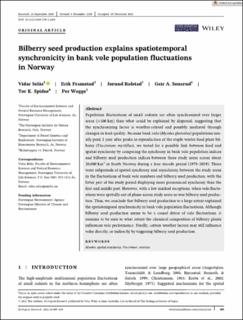Bilberry seed production explains spatiotemporal synchronicity in bank vole population fluctuations in Norway
Peer reviewed, Journal article
Published version
Date
2021Metadata
Show full item recordCollections
Abstract
Population fluctuations of small rodents are often synchronized over larger areas (>100 km) than what could be explained by dispersal, suggesting that the synchronizing factor is weather-related and possibly mediated through changes in food quality. Because bank vole (Myodes glareolus) populations usually peak 1 year after peaks in reproduction of the staple winter food plant bilberry (Vaccinium myrtillus), we tested for a possible link between food and spatial synchrony by comparing the synchrony in bank vole population indices and bilberry seed production indices between three study areas across about 20,000 km2 in South Norway during a four decade period (1979–2019). There were subperiods of spatial synchrony and asynchrony between the study areas in the fluctuations of bank vole numbers and bilberry seed production, with the latter part of the study period displaying more pronounced synchrony than the first and middle part. However, with a few marked exceptions, when vole fluctuations were spatially out of phase across study areas so was bilberry seed production. Thus, we conclude that bilberry seed production to a large extent explained the spatiotemporal synchronicity in bank vole population fluctuations. Although bilberry seed production seems to be a causal driver of vole fluctuations, it remains to be seen to what extent the chemical composition of bilberry plants influences vole performance. Finally, certain weather factors may still influence voles directly, or indirectly by triggering bilberry seed production.
